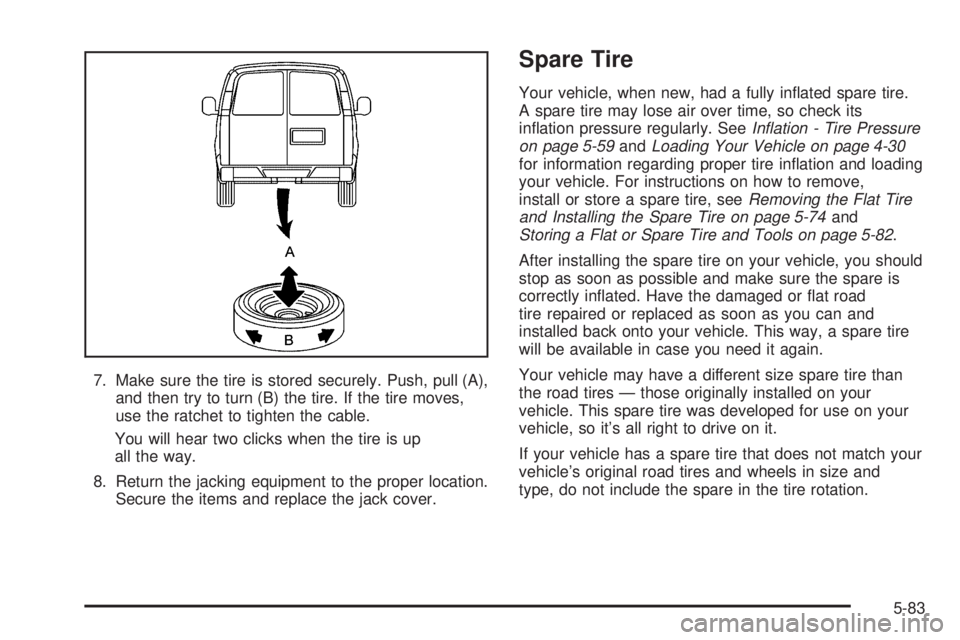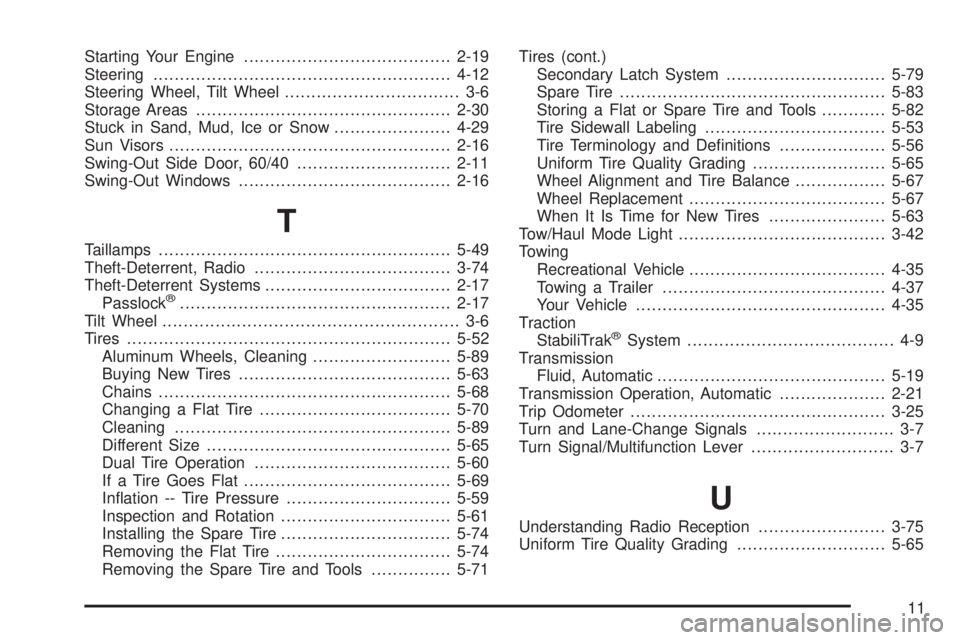2006 GMC SAVANA tire pressure
[x] Cancel search: tire pressurePage 331 of 394

7. Make sure the tire is stored securely. Push, pull (A),
and then try to turn (B) the tire. If the tire moves,
use the ratchet to tighten the cable.
You will hear two clicks when the tire is up
all the way.
8. Return the jacking equipment to the proper location.
Secure the items and replace the jack cover.
Spare Tire
Your vehicle, when new, had a fully inflated spare tire.
A spare tire may lose air over time, so check its
inflation pressure regularly. SeeIn�ation - Tire Pressure
on page 5-59andLoading Your Vehicle on page 4-30
for information regarding proper tire inflation and loading
your vehicle. For instructions on how to remove,
install or store a spare tire, seeRemoving the Flat Tire
and Installing the Spare Tire on page 5-74and
Storing a Flat or Spare Tire and Tools on page 5-82.
After installing the spare tire on your vehicle, you should
stop as soon as possible and make sure the spare is
correctly inflated. Have the damaged or flat road
tire repaired or replaced as soon as you can and
installed back onto your vehicle. This way, a spare tire
will be available in case you need it again.
Your vehicle may have a different size spare tire than
the road tires — those originally installed on your
vehicle. This spare tire was developed for use on your
vehicle, so it’s all right to drive on it.
If your vehicle has a spare tire that does not match your
vehicle’s original road tires and wheels in size and
type, do not include the spare in the tire rotation.
5-83
Page 353 of 394

MaintenanceI— Use MaintenanceIif the change
engine oil light comes on within 10 months since
the vehicle was purchased or MaintenanceIIwas
performed.MaintenanceII— Use MaintenanceIIif the previous
service performed was MaintenanceI. Always use
MaintenanceIIwhenever the message comes on
10 months or more since the last service or if the
message has not come on at all for one year.
Scheduled Maintenance
Service MaintenanceIMaintenanceII
Change engine oil and filter. SeeEngine Oil (Gasoline Engine) on page 5-13.
Reset oil life system. SeeEngine Oil Life System (Gasoline Engine) on
page 5-16.An Emission Control Service.••
Lubricate chassis components.See footnote #.••
Visually check for any leaks or damage.See footnote (j).••
Inspect engine air cleaner filter. If necessary, replace filter. SeeEngine Air
Cleaner/Filter on page 5-17.See footnote (l).•
Rotate tires and check inflation pressures and wear. SeeTire Inspection
and Rotation on page 5-61and “Tire Wear Inspection” inAt Least Once a
Month on page 6-10.••
Inspect brake system.See footnote (a).••
Check engine coolant and windshield washer fluid levels and add
fluid as needed.••
Perform any needed additional services. See “Additional Required
Services” in this section.••
Inspect suspension and steering components.See footnote (b).•
Inspect engine cooling system.See footnote (c).•
6-5
Page 358 of 394

At the First 100, 1,000 and 6,000
Miles (160, 1 600 and 10 000 km)
For vehicles with dual wheels, check dual wheel
nut torque. For proper torque, seeCapacities and
Speci�cations on page 5-98.
At Each Fuel Fill
It is important to perform these underhood checks at
each fuel �ll.
Engine Oil Level Check
Check the engine oil level and add the proper oil if
necessary. SeeEngine Oil (Gasoline Engine) on
page 5-13for further details.
Notice:It is important to check your oil regularly
and keep it at the proper level. Failure to keep your
engine oil at the proper level can cause damage
to your engine not covered by your warranty.
Engine Coolant Level Check
Check the engine coolant level and add
DEX-COOL®coolant mixture if necessary. SeeEngine
Coolant on page 5-21for further details.
Windshield Washer Fluid Level Check
Check the windshield washer fluid level in the windshield
washer fluid reservoir and add the proper fluid if
necessary.
At Least Once a Month
Tire In�ation Check
Visually inspect your vehicle’s tires and make sure they
are inflated to the correct pressures. Do not forget to
check the spare tire. SeeTires on page 5-52for further
details. Check to make sure the spare tire is stored
securely. SeeChanging a Flat Tire on page 5-70.
Tire Wear Inspection
Tire rotation may be required for high mileage highway
drivers prior to the Engine Oil Life System service
notification. Check the tires for wear and, if necessary,
rotate the tires. SeeTire Inspection and Rotation on
page 5-61.
6-10
Page 387 of 394

Exit Lighting...................................................3-15
Extender, Safety Belt.......................................1-31
Exterior Lamps...............................................3-13
F
Filter
Engine Air Cleaner......................................5-17
Finish Damage...............................................5-90
Fixed Mast Antenna........................................3-77
Flash-to-Pass................................................... 3-8
Flat Tire........................................................5-69
Flat Tire, Changing.........................................5-70
Flat Tire, Storing.............................................5-82
Fluid
Automatic Transmission................................5-19
Power Steering...........................................5-32
Windshield Washer......................................5-34
Front Axle......................................................5-44
Fuel............................................................... 5-5
Additives...................................................... 5-6
California Fuel.............................................. 5-6
Filling a Portable Fuel Container....................5-10
Filling Your Tank........................................... 5-8
Fuels in Foreign Countries.............................. 5-7
Gage.........................................................3-42
Gasoline Octane........................................... 5-5
Gasoline Specifications.................................. 5-5
Regulator...................................................2-20Fuses
Engine Compartment Fuse Block...................5-95
Floor Console Fuse Block.............................5-94
Fuses and Circuit Breakers...........................5-93
Windshield Wiper.........................................5-93
G
Gage
Check Gages Warning Light..........................3-42
Engine Coolant Temperature.........................3-35
Fuel..........................................................3-42
Oil Pressure...............................................3-38
Speedometer..............................................3-25
Voltmeter Gage...........................................3-32
Gasoline
Octane........................................................ 5-5
Specifications............................................... 5-5
GM Mobility Reimbursement Program.................. 7-5
H
Hazard Warning Flashers................................... 3-5
Headlamp Wiring............................................5-93
Headlamps....................................................5-47
Bulb Replacement.......................................5-46
Daytime Running Lamps...............................3-14
Flash-to-Pass............................................... 3-8
5
Page 388 of 394

Headlamps (cont.)
Front Turn Signal, Sidemarker and
Parking Lamps.........................................5-48
Halogen Bulbs............................................5-46
High/Low Beam Changer................................ 3-8
On Reminder..............................................3-14
Heater...........................................................3-17
Highbeam On Light.........................................3-41
Highway Hypnosis...........................................4-23
Hill and Mountain Roads..................................4-23
Hood
Checking Things Under................................5-10
Release.....................................................5-11
Horn............................................................... 3-6
How to Use This Manual...................................... ii
How to Wear Safety Belts Properly...................1-15
I
Ignition Positions.............................................2-18
Infants and Young Children, Restraints...............1-35
Inflation -- Tire Pressure..................................5-59
Instrument Panel
Overview..................................................... 3-4
Instrument Panel (I/P)
Brightness..................................................3-14
Cluster.......................................................3-24
J
Jump Starting.................................................5-39
K
Keyless Entry System....................................... 2-3
Keys............................................................... 2-2
L
Labeling, Tire Sidewall.....................................5-53
Lamps
Battery Run-Down Protection.........................3-16
Dome........................................................3-15
Dome Lamp Override...................................3-15
Exterior......................................................3-13
Reading.....................................................3-15
LATCH System
Child Restraints...........................................1-44
Light
Airbag Off..................................................3-28
Airbag Readiness........................................3-27
Anti-Lock Brake System Warning...................3-34
Brake System Warning.................................3-33
Change Engine Oil......................................3-39
Charging System.........................................3-32
Check Gages Warning.................................3-42
Cruise Control.............................................3-40
6
Page 391 of 394

R
Radiator Pressure Cap....................................5-24
Radios..........................................................3-43
AM-FM Radio.............................................3-45
Care of Your Cassette Tape Player................3-75
Care of Your CD Player...............................3-77
Care of Your CDs........................................3-76
Radio with Cassette and CD.........................3-52
Radio with CD............................................3-47
Radio with Six-Disc CD................................3-63
Setting the Time for Radios with Radio
Data Systems (RDS)................................3-44
Setting the Time for Radios without
Radio Data Systems (RDS).......................3-44
Theft-Deterrent............................................3-74
Understanding Reception..............................3-75
Reading Lamps..............................................3-15
Rear Air Conditioning and Heating System.........3-21
Rear Axle......................................................5-44
Locking........................................................ 4-8
Rear Door Security Locks.................................. 2-8
Rear Doors....................................................2-12
Rear Heating System......................................3-21
Rear Outside Passenger Positions, Safety Belts.....1-25
Rear Safety Belt Comfort Guides......................1-28
Rear Seat Operation......................................... 1-7Rearview Mirrors.............................................2-28
Reclining Seatbacks.......................................... 1-5
Recommended Fluids and Lubricants.................6-13
Recreational Vehicle Towing.............................4-35
Reduced Engine Power Light............................3-41
Remote Keyless Entry System............................ 2-3
Remote Keyless Entry System, Operation............ 2-4
Removing the Flat Tire and Installing
the Spare Tire.............................................5-74
Removing the Spare Tire and Tools...................5-71
Replacement Bulbs.........................................5-50
Reporting Safety Defects
Canadian Government..................................7-14
General Motors...........................................7-14
United States Government............................7-13
Restraint System Check
Checking the Restraint Systems....................1-81
Replacing Restraint System Parts
After a Crash..........................................1-81
Retained Accessory Power (RAP)......................2-18
Right Front Passenger Position, Safety Belts......1-23
Roadside
Assistance Program....................................... 7-6
Rocking Your Vehicle to Get it Out....................4-30
Running the Engine While Parked.....................2-27
9
Page 393 of 394

Starting Your Engine.......................................2-19
Steering........................................................4-12
Steering Wheel, Tilt Wheel................................. 3-6
Storage Areas................................................2-30
Stuck in Sand, Mud, Ice or Snow......................4-29
Sun Visors.....................................................2-16
Swing-Out Side Door, 60/40.............................2-11
Swing-Out Windows........................................2-16
T
Taillamps.......................................................5-49
Theft-Deterrent, Radio.....................................3-74
Theft-Deterrent Systems...................................2-17
Passlock
®...................................................2-17
Tilt Wheel........................................................ 3-6
Tires.............................................................5-52
Aluminum Wheels, Cleaning..........................5-89
Buying New Tires........................................5-63
Chains.......................................................5-68
Changing a Flat Tire....................................5-70
Cleaning....................................................5-89
Different Size..............................................5-65
Dual Tire Operation.....................................5-60
If a Tire Goes Flat.......................................5-69
Inflation -- Tire Pressure...............................5-59
Inspection and Rotation................................5-61
Installing the Spare Tire................................5-74
Removing the Flat Tire.................................5-74
Removing the Spare Tire and Tools...............5-71Tires (cont.)
Secondary Latch System..............................5-79
Spare Tire..................................................5-83
Storing a Flat or Spare Tire and Tools............5-82
Tire Sidewall Labeling..................................5-53
Tire Terminology and Definitions....................5-56
Uniform Tire Quality Grading.........................5-65
Wheel Alignment and Tire Balance.................5-67
Wheel Replacement.....................................5-67
When It Is Time for New Tires......................5-63
Tow/Haul Mode Light.......................................3-42
Towing
Recreational Vehicle.....................................4-35
Towing a Trailer..........................................4-37
Your Vehicle...............................................4-35
Traction
StabiliTrak
®System....................................... 4-9
Transmission
Fluid, Automatic...........................................5-19
Transmission Operation, Automatic....................2-21
Trip Odometer................................................3-25
Turn and Lane-Change Signals.......................... 3-7
Turn Signal/Multifunction Lever........................... 3-7
U
Understanding Radio Reception........................3-75
Uniform Tire Quality Grading............................5-65
11